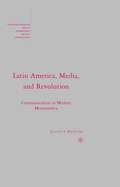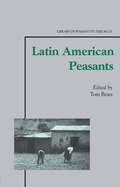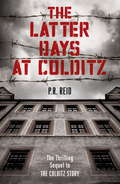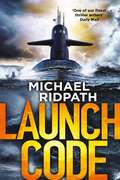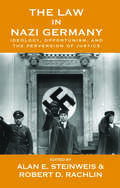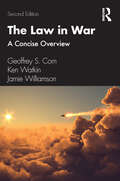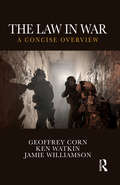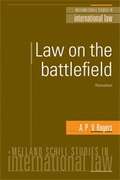- Table View
- List View
Latin America, Media, and Revolution: Communication in Modern Mesoamerica (The Palgrave Macmillan Series in International Political Communication)
by J. DarlingThis book compares rebel media use in three Mesoamerican rebellions: the Nicaraguan Revolution, the Salvadoran civil war and the Zapatista uprising in Chiapas, Mexico. Directly comparing media use in all three rebellions provides a richer understanding of the role of media in social change, particularly violent change.
Latin American Peasants
by Tom BrassThe essays in this collection examine agrarian transformation in Latin America and the role in this of peasants, with particular reference to Bolivia, Peru, Chile, Brazil and Central America. Among the issues covered are the impact of globalization and neo-liberal economic policies.
Latin American Peasants
by Tom BrassThe essays in this collection examine agrarian transformation in Latin America and the role in this of peasants, with particular reference to Bolivia, Peru, Chile, Brazil and Central America. Among the issues covered are the impact of globalization and neo-liberal economic policies.
Latin American Wars 1900–1941: "Banana Wars," Border Wars & Revolutions (Men-at-Arms)
by Stephen Walsh Philip JowettFrom the Mexican Revolution to the Zarumilla War, in the first 40 years of the 20th century the nations of Central and South America were frequently disturbed by border clashes, civil wars and revolution. Many of these conflicts became known as 'Banana Wars'. Some involved only lightly armed guerrillas, but others saw armies operating artillery and armoured vehicles, supported by aircraft and river navies. The conflicts in Honduras and Nicaragua saw the intervention of US Marines, and later wars involved armour and aircraft from the militaries of Europe.Using detailed colour plates and a wealth of contemporary photographs, this book shows the uniforms, equipment and strategies of the armies involved in these conflicts little known in the West. Covering wars crossing the length and breadth of the continent, this is the fascinating account of the wars that helped shape modern Latin America.
Latin American Wars 1900–1941: "Banana Wars," Border Wars & Revolutions (Men-at-Arms #519)
by Stephen Walsh Philip JowettFrom the Mexican Revolution to the Zarumilla War, in the first 40 years of the 20th century the nations of Central and South America were frequently disturbed by border clashes, civil wars and revolution. Many of these conflicts became known as 'Banana Wars'. Some involved only lightly armed guerrillas, but others saw armies operating artillery and armoured vehicles, supported by aircraft and river navies. The conflicts in Honduras and Nicaragua saw the intervention of US Marines, and later wars involved armour and aircraft from the militaries of Europe.Using detailed colour plates and a wealth of contemporary photographs, this book shows the uniforms, equipment and strategies of the armies involved in these conflicts little known in the West. Covering wars crossing the length and breadth of the continent, this is the fascinating account of the wars that helped shape modern Latin America.
The Latter Days at Colditz (Cassell Military Paperbacks Ser.)
by Major P ReidIn THE COLDITZ STORY, Pat Reid told the story of the escape academythat sprang up inside the most impregnable German POW camp of the Second World War, ending appropriately with his own incredible escape from Colditz. But Reid's own break-out was by no means the last. In this enthralling sequel, he follows the fortunes of the escape academy right up until the arrival of the allied forces in April 1945. These tales of fantastic bravery and stunning ingenuity are every bit as mesmerising as the original.A true classic, LATTER DAYS AT COLDITZ is the bestselling conclusion to the story of the infamous German P.O.W. camp.
Launch Code: Perfect for fans of Mark Dawson and Mark Billingham
by Michael Ridpath'Hugely enjoyable and thought-provoking, Launch Code brings to mind the classic thrillers of Alister Maclean and Jack Higgins. A well-crafted ingenious mystery, tightly plotted, compelling and contemporary, this could well be Michael Ridpath's best novel yet.' - Stav Sherez, author of the Carrigan & Miller series1983: Three hundred feet beneath the Atlantic, submarine Lieutenant Bill Guth receives the order he's been dreading: a full nuclear strike against the USSR. Crisis is soon averted, but in the chaos that follows, one crew member ends up dead...2019: Bill's annual family gathering is interrupted when a historian turns up, eager to uncover the truth about the near-apocalyptic Cold War incident. Bill refuses to answer, but that night the man is brutally murdered.What happened all those years ago? How much is Bill to blame for events in the past? And who will stop at nothing to keep the secrets of 1983 where they belong?'Deadly state secrets and deadlier family secrets - perfectly crafted, scrupulously researched Launch Code weaves an ingeniously dark and tangled web that will keep you gripped and guessing to the very end. Ridpath is one of the best thriller writers around.' - Craig Russell, author of The Devil Aspect
LAV-25: The Marine Corps’ Light Armored Vehicle (New Vanguard)
by James D’AnginaThe Light Armored Vehicle 25 (LAV-25) has played a significant role in transforming United States Marine Corps doctrine since its introduction in the early 1980s. The Marine Corps' Light Armored Vehicle program was based on the proven Swiss MOWAG Piranha series of 4x4, 6x6, and 8x8 wheeled vehicles. However, developing organizational units, tactics, and employment of the weapon system within the force structure of the Marine Corps proved to be more of a challenge than fielding the weapon system. This resulted in multiple re-designations for LAV units within the Corps. The LAV first saw combat in Panama during Operation Just Cause and LAV-25s have fought in every major conflict since, including Operation Enduring Freedom, and Operation Iraqi Freedom. This book covers the design, development, and deployment of this continuingly successful vehicle.
LAV-25: The Marine Corps’ Light Armored Vehicle (New Vanguard)
by Henry Morshead James D’AnginaThe Light Armored Vehicle 25 (LAV-25) has played a significant role in transforming United States Marine Corps doctrine since its introduction in the early 1980s. The Marine Corps' Light Armored Vehicle program was based on the proven Swiss MOWAG Piranha series of 4x4, 6x6, and 8x8 wheeled vehicles. However, developing organizational units, tactics, and employment of the weapon system within the force structure of the Marine Corps proved to be more of a challenge than fielding the weapon system. This resulted in multiple re-designations for LAV units within the Corps. The LAV first saw combat in Panama during Operation Just Cause and LAV-25s have fought in every major conflict since, including Operation Enduring Freedom, and Operation Iraqi Freedom. This book covers the design, development, and deployment of this continuingly successful vehicle.
Lavender Road (London At War Ser. #Vol. 1)
by Helen CareyWorld War II has begun. As war rages, and the evacuation of Dunkirk approaches, the women of south London have their own battles to fight. Helen Carey's LONDON ROAD is a compelling novel perfect for fans of Lilian Harry, Kate Thompson and Annie Murray. September 1939As the nation braces itself for war, the residents of Lavender Road are dealing with troubles of their own.With her husband in jail, Joyce Carter is never sure where her family's next meal will come from. And her troublesome daughter, Jen, isn't helping matters by refusing to work until she achieves her dream of becoming an actress.Pam Nelson is struggling to deny the distance growing between her and her husband - which isn't helped by her secret attraction to their handsome new lodger. And unfortunately Pam isn't the only one to fall for his seductive charm...As the threat of a German invasion looms, the lives of the women on this south London street are about to change for ever...
The Law in Nazi Germany: Ideology, Opportunism, and the Perversion of Justice (Vermont Studies on Nazi Germany and the Holocaust #5)
by Alan E. Steinweis and Robert D. RachlinWhile we often tend to think of the Third Reich as a zone of lawlessness, the Nazi dictatorship and its policies of persecution rested on a legal foundation set in place and maintained by judges, lawyers, and civil servants trained in the law. This volume offers a concise and compelling account of how these intelligent and welleducated legal professionals lent their skills and knowledge to a system of oppression and domination. The chapters address why German lawyers and jurists were attracted to Nazism; how their support of the regime resulted from a combination of ideological conviction, careerist opportunism, and legalistic selfdelusion; and whether they were held accountable for their Nazi-era actions after 1945. This book also examines the experiences of Jewish lawyers who fell victim to anti-Semitic measures. The volume will appeal to scholars, students, and other readers with an interest in Nazi Germany, the Holocaust, and the history of jurisprudence.
The Law in War: A Concise Overview
by Geoffrey S. Corn Ken Watkin Jamie WilliamsonThe Law in War offers an insightful roadmap to understanding a broad range of operational, humanitarian, and accountability issues that arise during armed conflict. Each chapter provides a clear and comprehensive explanation of the impact that international law has on military operations. The second edition has been fully revised to reflect recent advances in international humanitarian law and expands the analysis to include as a brand-new chapter on international human rights law, which addresses issues such as the conduct of law enforcement during hostilities. With a particular focus on updates concerning the status of combatants and unprivileged belligerents, the protection of civilians, targeting, the treatment of POWs and detainees, weapons law, air and missile warfare, naval warfare and neutrality, command responsibility, and accountability. New material has also been added to address the increasing involvement of private security contractors in warfare.The Law in War is an ideal text for students in a variety of domains, to include international humanitarian law, international human rights law, international relations, and military science. It is also a valuable resource for those involved in the planning, execution, and critique of military operations across the spectrum of conflict.
The Law in War: A Concise Overview
by Geoffrey S. Corn Ken Watkin Jamie WilliamsonThe Law in War offers an insightful roadmap to understanding a broad range of operational, humanitarian, and accountability issues that arise during armed conflict. Each chapter provides a clear and comprehensive explanation of the impact that international law has on military operations. The second edition has been fully revised to reflect recent advances in international humanitarian law and expands the analysis to include as a brand-new chapter on international human rights law, which addresses issues such as the conduct of law enforcement during hostilities. With a particular focus on updates concerning the status of combatants and unprivileged belligerents, the protection of civilians, targeting, the treatment of POWs and detainees, weapons law, air and missile warfare, naval warfare and neutrality, command responsibility, and accountability. New material has also been added to address the increasing involvement of private security contractors in warfare.The Law in War is an ideal text for students in a variety of domains, to include international humanitarian law, international human rights law, international relations, and military science. It is also a valuable resource for those involved in the planning, execution, and critique of military operations across the spectrum of conflict.
The Law in War: A Concise Overview
by Geoffrey Corn Ken Watkin Jamie WilliamsonThis book provides a comprehensive yet concise overview of key issues related to the regulation of armed hostilities between States, and between States and non-State groups. Coverage begins with an explanation of the conditions that result in the applicability of international humanitarian law, and then subsequently addresses how the law influences a broad range of operational, humanitarian, and accountability issues that arise during military operations. Each chapter provides a clear and comprehensive explanation of humanitarian law, focusing especially on how it impacts operations. The chapters also highlight both contemporary controversies in the field and potentially emerging norms of the law. The book is an ideal text for students studying international humanitarian law for the first time, as well as an excellent introduction for students and practitioners of public international law and international relations.
The Law of Armed Conflict: Constraints on the Contemporary Use of Military Force (Global Interdisciplinary Studies Series)
by Howard M. HenselModern armed conflict has taken a variety of forms and occurs at a variety of levels, raising serious questions concerning the relationship between the law of armed conflict and the reality of contemporary warfare. Many contemporary armed conflicts are fought in pursuit of unlimited objectives, whereas other modern wars seek to advance limited goals. While in some cases modern wars are fought by traditional armies composed of clearly identifiable soldiers, often modern armed conflicts are waged by guerrilla or partisan fighters whose identities are easily confused with non-combatants. Terrorism is increasingly a characteristic manifestation of this contemporary warfare. In the broadest sense, contemporary warfare has raised often controversial and vexing questions concerning the applicability of the law of armed conflict and, when applicable, the interpretation of its principles and tenets. This engaging volume addresses some of the contemporary normative and legal challenges and problems associated with the application of the concepts of just war, the just conduct of war, and the law of armed conflict to 21st century warfare.
The Law of Armed Conflict: Constraints on the Contemporary Use of Military Force (Global Interdisciplinary Studies Series)
by Howard M. HenselModern armed conflict has taken a variety of forms and occurs at a variety of levels, raising serious questions concerning the relationship between the law of armed conflict and the reality of contemporary warfare. Many contemporary armed conflicts are fought in pursuit of unlimited objectives, whereas other modern wars seek to advance limited goals. While in some cases modern wars are fought by traditional armies composed of clearly identifiable soldiers, often modern armed conflicts are waged by guerrilla or partisan fighters whose identities are easily confused with non-combatants. Terrorism is increasingly a characteristic manifestation of this contemporary warfare. In the broadest sense, contemporary warfare has raised often controversial and vexing questions concerning the applicability of the law of armed conflict and, when applicable, the interpretation of its principles and tenets. This engaging volume addresses some of the contemporary normative and legal challenges and problems associated with the application of the concepts of just war, the just conduct of war, and the law of armed conflict to 21st century warfare.
The Law Of Armed Conflict: International Humanitarian Law In War, Second Edition
by Gary D. SolisNewly revised and expanded, The Law of Armed Conflict, 2nd edition introduces law students and undergraduates to the law of war in an age of terrorism. What law of armed conflict (LOAC), or its civilian counterpart, international humanitarian law (IHL), applies in a particular armed conflict? Are terrorists legally bound by that law? What constitutes a war crime? What (or who) is a lawful target and how are targeting decisions made? What are 'rules of engagement' and who formulates them? How can an autonomous weapon system be bound by the law of armed conflict? Why were the Guantánamo military commissions a failure? This book takes students through these LOACIHL questions and more, employing real-world examples and legal opinions from the US and abroad. From Nuremberg to 9/11, from courts-martial to the US Supreme Court, from the nineteenth century to the twenty-first, the law of war is explained, interpreted, and applied.
The Law of Nations and Britain’s Quest for Naval Security: International Law and Arms Control, 1898–1914
by Scott Andrew KeeferAs the centenary of the Treaty of Versailles approaches, this book presents the pre-1914 precursors to the interwar naval arms treaties arising from the peace of 1919, providing a fresh perspective on arms control efforts through an interdisciplinary approach. Interweaving historical investigation with legal analysis, Scott Keefer traces the British role in the development of naval arms control, outlining the pragmatic Foreign Office approaches towards international law. By emphasizing what was possible within the existing legal system rather than attempting to create radically powerful international institutions, statesmen crafted treaties to exploit the unique pace of naval construction. Utilizing previously-overlooked archival resources, this book investigates how the great powers exploited treaties as elements of national security strategies. The result is a fuller analysis of the Hague Peace Conferences, Anglo-German discussions, and lesser known regional agreements from the American Great Lakes to South America, and a richer exploration of pre-1914 diplomacy, providing insights into how a past generation perceived questions of war and defence.
The Law of War (Justice, International Law and Global Security)
by Ingrid DetterThe third edition of Ingrid Detter's authoritative work explores the changing legal context of modern warfare in light of events over the last decade. Ingrid Detter reviews the status of non-State actors, as individuals and groups become more prominent in international society. Covering post 9/11 events and the resulting changes in the ethos of war, the author analyses the role of military companies and examines what their legitimacy means for international society. The edition also discusses certain ’intrinsic’ rules in the Law of War, such as rules giving individuals the right to be spared genocide, torture, slavery and apartheid and assure them basic democratic rights. The author questions the right of ’illegal’ combatants to be treated as prisoners of war and suggests that a minimum standard must be afforded to all, whether captured dictators or detainees suspected of terrorism. In the modern world, the individual (the soldier, the civilian, the dictator, the terrorist or the pirate) can no longer behave as they wish. Further new topics include 'target killings', the ’right to protect’ (’R2P’, - claimed to be a new form of intervention), the use of unregulated weapons such as drones and robots, the war scenario in Outer Space and cyber crimes. There is also a discussion of new developments in the field of war crimes including severe criticism of the novel concept 'joint criminal enterprise' (JCE), which, in the opinion of the author, undermines the Rule of Law. This updated and expanded edition will be of use to statesmen, scholars and students of international relations and international law.
The Law of War (Justice, International Law and Global Security)
by Ingrid DetterThe third edition of Ingrid Detter's authoritative work explores the changing legal context of modern warfare in light of events over the last decade. Ingrid Detter reviews the status of non-State actors, as individuals and groups become more prominent in international society. Covering post 9/11 events and the resulting changes in the ethos of war, the author analyses the role of military companies and examines what their legitimacy means for international society. The edition also discusses certain ’intrinsic’ rules in the Law of War, such as rules giving individuals the right to be spared genocide, torture, slavery and apartheid and assure them basic democratic rights. The author questions the right of ’illegal’ combatants to be treated as prisoners of war and suggests that a minimum standard must be afforded to all, whether captured dictators or detainees suspected of terrorism. In the modern world, the individual (the soldier, the civilian, the dictator, the terrorist or the pirate) can no longer behave as they wish. Further new topics include 'target killings', the ’right to protect’ (’R2P’, - claimed to be a new form of intervention), the use of unregulated weapons such as drones and robots, the war scenario in Outer Space and cyber crimes. There is also a discussion of new developments in the field of war crimes including severe criticism of the novel concept 'joint criminal enterprise' (JCE), which, in the opinion of the author, undermines the Rule of Law. This updated and expanded edition will be of use to statesmen, scholars and students of international relations and international law.
Law on the battlefield: Third edition (Melland Schill Studies in International Law)
by General A. P. RogersThis book, now fully updated and in its third edition, explains the law relating to the conduct of hostilities and provides guidance on difficult or controversial aspects of the law. It covers who or what may legitimately be attacked and what precautions must be taken to protect civilians, cultural property or the natural environment. It deals with the responsibility of commanders and how the law is enforced. There are also chapters on internal armed conflicts and the security aspects of belligerent occupation.
Law on the battlefield (Melland Schill Studies In International Law)
by A.P.V RogersThis book, now fully updated and in its third edition, explains the law relating to the conduct of hostilities and provides guidance on difficult or controversial aspects of the law. It covers who or what may legitimately be attacked and what precautions must be taken to protect civilians, cultural property or the natural environment. It deals with the responsibility of commanders and how the law is enforced. There are also chapters on internal armed conflicts and the security aspects of belligerent occupation.
Lawless: A lawyer’s unrelenting fight for justice in a war zone
by Kimberley MotleyIn the summer of 2008 Kimberley Motley quit her job as a public defender in Milwaukee to join a program that helped train lawyers in war-torn Afghanistan. She was thirty-two at the time, a mother of three who had never travelled outside the United States. What she brought to Afghanistan was a toughness and resilience which came from growing up in one of the most dangerous cities in the US, a fundamental belief in everyone's right to justice and an unconventional legal mind that has made her a legend in an archaic, misogynistic and deeply conservative environment. Through sheer force of personality, ingenuity and perseverance, Kimberley became the first foreign lawyer to practise in Afghanistan and her work swiftly morphed into a mission - to bring 'justness' to the defenceless and voiceless. She has established herself as an expert on its fledgling criminal justice system, able to pivot between the country's complex legislation and its religious laws in defence of her clients. Her radical approach has seen her successfully represent both Afghans and Westerners, overturning sentences for men and women who've been subject to often appalling miscarriages of justice. Inspiring and fascinating in equal measure, Lawless tells the story of a remarkable woman operating in one of the most dangerous countries in the world.
Lawrence in Arabia: War, Deceit, Imperial Folly and the Making of the Modern Middle East
by Scott AndersonThe Sunday Times Top Ten Bestseller 2014New York Times top ten bestseller 2014Amazon.com's Top Ten History Books of the Year 2014New York Times Book of the Year 2014The Arab Revolt against the Turks in World War One was, in the words of T.E. Lawrence, 'a sideshow of a sideshow'. Amidst the slaughter in European trenches, the Western combatants paid scant attention to the Middle Eastern theatre. As a result, the conflict was shaped to a remarkable degree by a small handful of adventurers and low-level officers far removed from the corridors of power. At the centre of it all was Lawrence. In early 1914 he was an archaeologist excavating ruins in the sands of Syria; by 1917 he was battling both the enemy and his own government to bring about the vision he had for the Arab people. Operating in the Middle East at the same time, but to wildly different ends, were three other important players: a German attaché, an American oilman and a committed Zionist. The intertwined paths of these four young men - the schemes they put in place, the battles they fought, the betrayals they endured and committed - mirror the grandeur, intrigue and tragedy of the war in the desert.
Lawrence of Arabia: The definitive 21st-century biography of a 20th-century soldier, adventurer and leader
by Ranulph FiennesDiscover the authoritative, illuminating biography of T. E. Lawrence – the man who inspired the iconic film Lawrence of Arabia – from The World's Greatest Living Explorer Ranulph Fiennes‘An excellent guide to a colourful life for readers who enjoy tales of adventure in the desert sands’ Daily Telegraph 'Corking, rip-roaring, crisply written, full of extraordinary characters. An immaculate retelling of this cracking story' Daily Mail---Thomas Edward Lawrence first set foot on the hot sands of Arabia in 1909. By 1918 there was a £20,000 price on his head. How did this fresh-faced archaeologist, liaison and map officer end up fighting alongside guerrilla forces during the Arab Revolt? How did a slight man journey more than 300 miles through blistering heat to capture Aqaba? And how did an unhappy outsider take a pivotal role in peace conferences to decide the future of the Middle East? Explorer Ranulph Fiennes tells the extraordinary story of how Lawrence gave over his life fully to this land and its peoples, while making enemies of those who sought to subjugate it . . . --- ‘Gripping. Rattles along like an enthralling Boys’ Own adventure’ Irish Independent ‘Fiennes' own experiences certainly allow him to write vividly and with empathy’ Sunday Times ‘Elegant, subtle, sympathetic’ Wall Street Journal
